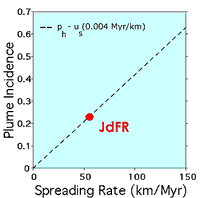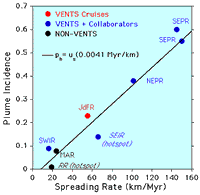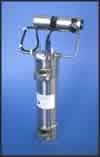| . | Global Predictions |
|
Global predictions from Hydrothermal Plume Surveys
By 1990, all segments of the Juan de Fuca Ridge had been surveyed for hydrothermal plumes. About 25% of the length of the ridge was overlain by hydrothermal plumes, which was defined as a "plume incidence" of 0.25. The Juan de Fuca Ridge is a medium rate spreading center, adding about 6 centimeters of new seafloor per year. Spreading rate is a measure of the rate of magma supply, which ultimately provides the source of new lava for the seafloor, A number of geological indexes are used to characterize mid-ocean ridges and the robustness of their axial magma chambers based on structural characteristics of ridge segments.
An hypothesis was proposed, based on the Juan de Fuca Ridge example of a medium rate spreading center with plume incidence of 0.25 (images right), that the large-scale distribution of hydrothermal venting could be predicted as a linear function of the spreading rate of any ridge (see Baker and Hammond (1992)). Six years and a lot of collaborations later we now have more information in support of this hypothesis. The fastest spreading ridges are overlain by hydrothermal plumes along half their length, while venting is exceedingly rare along the slowest ridges.
Plume incidence is also being compared with other geological indexes such as cross-axis inflation, ridge crest elevation, the presence of an axial magma chamber reflector (AMC reflector) and others (read Baker, E.T. (1996) for details). A multidisciplinary survey of the Southern EPR between 28-32oS during March-April, 1998 aboard the R/V MELVILLE has given us the first opportunity to simultaneously map the patterns of distribution of hydrothermal activity and that of faults, fissures and young volcanic eruptive sites that define the spreading axes along a superfast spreading section of the MOR. The data from this cruise allow a direct comparison between hydrothermal and crustal variables and support the hypothesis that there are hierarchical controls on the distribution of hydrothermal activity along ridge crests. At the largest (multi-segment) scale, spreading rate is the primary control. At the 2nd/3rd-order segment scale, inflation appears dominant. At within-segment scales, the effect of individual spreading events likely is most important (see references below for additional information). What can we learn from the global distribution of hydrothermal venting?
Here's one example: We can estimate the distribution of convective heat flux along the entire Mid-Ocean Ridge axis by quantifying the heat flux at several vent fields then projecting the global frequency of vent fields according to the spreading rate. In this figure, the hydrothermal heat for different sections of the Mid-Ocean Ridge is shown in black, not including the western Pacific back-arc basins. The total is a little less than 2 TW. John Lupton has used the heat flux to calculate the vertical pumping of plumes, that is, the volume of water entrained and carried upward across isopycnals by each J of heat. The total is ~12 Sv, of which almost half are in the equatorial Pacific. While these estimates are very rough, it appears that the vertical mass transport of water by hydrothermal processes is not insignificant compared to thermohaline processes.
References: Baker, E.T., and S.R. Hammond (1992): Hydrothermal venting and the apparent magmatic budget of the Juan de Fuca Ridge. Journal of Geophysical Research, 97(B3), 3443-3456. Baker, E.T. (1996): Geological indexes of hydrothermal venting. Journal of Geophysical Research, 101(B6), 13,741-13,753. Baker, E.T., C.R. German, and H. Elderfield (1995): Hydrothermal plumes over spreading-center axes: Global distributions and geological inferences. In Seafloor Hydrothermal Systems: Physical, Chemical, Biological, and Geological Interactions, S. Humphris, R. Zierenberg, L. Mullineaux, and R. Thomson (eds.), Geophysical Monograph 91, American Geophysical Union, Washington, D.C., 47-71. German, C.R., E.T. Baker, and G. Klinkhammer (1995): Regional setting of hydrothermal activity. In Hydrothermal Vents and Processes, L.M. Parson, C.L. Walker, and D.R. Dixon (eds.), Geological Society Special Publication No. 87, 3-15. Urabe, T., E.T. Baker, J. Ishibashi, R.A. Feely, K. Marumo, G.J. Massoth, A. Maruyama, K. Shitashima, K. Okamura, J.E. Lupton, A. Sonoda, T. Yamazaki, M. Aoki, J. Gendron, R. Greene, Y. Kaiho, K. Kisimoto, G. Lebon, T. Matsumoto, K. Nakamura, A. Nishizawa, O. Okano, G. Paradis, K. Roe, T. Shibata, D. Tennant, T. Vance, S.L. Walker, T. Yabuki, and N. Ytow (1995): The effect of magmatic activity on hydrothermal venting along the superfast-spreading East Pacific Rise. Science, 269, 1092-1095. Baker, E.T., Y.J. Chen, and J. Phipps Morgan (1996): The relationship between near-axis hydrothermal cooling and the spreading rate of mid-ocean ridges. Earth and Planetary Science Letters, 142, 137-145. Baker, E.T., and T. Urabe (1996): Extensive distribution of hydrothermal plumes along the superfast spreading East Pacific Rise, 13°13'-18°40'S. Journal of Geophysical Research, 101(B4), 8685-8695. Scheirer, D.S., E.T. Baker, and K.T.M. Johnson (1998): Detection of hydrothermal plumes along the Southeast Indian Ridge near the Amsterdam-St. Paul Plateau. Geophysical Research Letters, 25(1), 97-100. German, C.R., E.T. Baker, C. Mevel, K. Tamaki, and FUJI Scientific Team (1998): Hydrothermal activity along the southwest Indian Ridge. Nature (In press).
|





